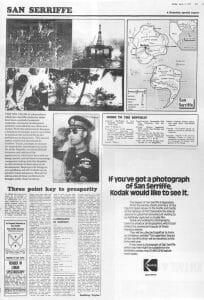A lot of sites and publications will be running crazy stories as true to try to trick you today. Not me.
It is a bit of a tradition, but This is True is …well… true stuff!
Though they canceled releasing jokes in 2020 and 2021 in respect for the suffering of the pandemic, Google is well known for its April Fools gags, such as:
- In 2019, Google’s subsidiary in the Netherlands released a video on YouTube about a new app allowing communication with tulips.
- In 2018, Google said it was releasing a “Bad Joke Detector” to free up storage by deleting bad jokes from the user’s device. If it worked, the first to go would be the “Bad Joke Detector”.
- Also in 2019, YouTube ran an “ad” on the top of its home page for an Aquaman 2 movie, but instead of the link going to a video for a trailer, the link was (are you ready for THIS?!) for the Shazam! trailer instead. Hard to stop laughing at that, eh?
That’s what some of the greatest minds in tech came up with?! Boy, our suffering started way before the pandemic.
So let’s celebrate several of the absolute best April Fools jokes of the past, executed by real experts.
Don’t try this at home.
1933: The Madison Capital Times
The Madison, Wisc., Capital Times ran a front-page story on April 1 to report that the state capitol dome had collapsed. “Wisconsin’s beautiful $8 million capitol was in ruins today,” the report said, “following a series of mysterious explosions which blasted the majestic dome from its base.”

The explosions, it continued, “sent showers of granite chips down upon the heads of pedestrians.” The headline: “Dome Topples Off Statehouse”. The subhead: “Officials Say Legislature Generated Too Much Hot Air”.
Well that’s definitely plausible!
“Authorities were considering the possibility that large quantities of gas,” the article explained, “generated through many weeks of verbose debate in the Senate and Assembly chambers, had in some way been ignited, causing the first blast.”
That explanation, of course, was just too believable: even though the story ended “April Fools” (and that was noted under the photo, too), readers raced to downtown Madison to see the destroyed building, and were gobsmacked to see it was fully intact.
“I was filled with indignation over your April Fool joke on the front page of the Capital-Times of April 1,” a reader complained, once he figured out the date of the story (or perhaps looked more closely and saw the “April Fools” note and realized he was one of the fools). “There is such a thing as carrying a joke too far and this one was not only tactless and void of humor, but also a hideous jest.”
Today, that $8 million-in-1933 dome would be the equivalent of about $180 million. That’s one hell of an expensive state capitol dome! No wonder taxpayers got up in arms.
The story and photo were created by reporter Cedric Parker. It was far from his last gag: on April 1, 1966, a Parker story told about a man who lived on Lake Waubesa who had trained ducks to tow his rowboat out whenever he wanted to go fishing. Parker created a picture showing ducks harnessed to the boat, with the man sitting back rather than having to row.
1957: BBC’s Panorama
The April 1 edition of the popular British TV show Panorama ran a two-and-a-half-minute story about how the Swiss harvested fresh spaghetti from trees (embedded below). It was a great crop that year, the show reported, thanks both to perfect weather and the “virtual disappearance of the spaghetti weevil.”

The show’s Very Dignified Host, Richard Dimbleby, concluded that “For those who love this dish, there’s nothing like real, home-grown spaghetti.”
Brits fell for it dish, fork, and napkin: hundreds inquired of the BBC how they might grow spaghetti at home. The BBC, continuing the joke, simply told them to “Place a sprig of spaghetti in a tin of tomato sauce and hope for the best.”
The report, thought to be the first televised April Fools joke, was thought up by Panorama cameraman Charles de Jaeger (who was Austrian, not Swiss, but he filmed the spot on a side-trip while in Switzerland). He was given a £100 budget for the props and film.
Happily, the Beeb posted the report on Youtube:
1977: London Guardian

Yep, the Brits again: they get dry humor (er… humour). Or, as the case may be, don’t get it.
The April 1 edition of the London Guardian newspaper included a supplement about the Indian Ocean island nation of San Serriffe. These days, anyone with a good laser printer might know printer terms and font names (“sans serif” means without serifs — the little “decorations” on letters, such as the “feet” which can be seen in serifed fonts.)
If the more obscure place names (click graphic to enlarge it) like Bodoni (a font face), Gill Sands (Gill sans — short for sans [aka without] serif — is a font face), or “Upper and Lower Caisse” weren’t clues enough, the semi-colon shape of the islands could be seen from across the room.
Naturally, hundreds of readers called the Guardian for more information, including asking how they might book vacations to the islands.

The paper’s Special Reports editor, Philip Davies, came up with the idea. “The Financial Times was always doing special reports on little countries I’d never heard of,” Davies said. “I was thinking about April Fool’s Day 1977 and I thought: why don’t we just make a country up?”
The paper even managed to get advertisers to play along, which means they even made money on the joke. So many advertisers jumped in they had to publish an amazing seven pages on the fake island.
It was the largest special report the Guardian had ever published, and it was all brilliantly bogus.
Now Ask Yourself
Can any of the lame attempts at jokes today beat these classics?
I doubt it — no foolin’. But it is the type of humor I sprinkle onto This is True stories to make the newsletter fun to read each week. If you don’t already subscribe, click here to open a subscribe form. Basic subscriptions have been free since 1994.
[Adapted from my original text published 1 April 2013 in the True Story section of my now defunct Jumbo Joke site.]– – –
Bad link? Broken image? Other problem on this page? Use the Help button lower right, and thanks.
This page is an example of my style of “Thought-Provoking Entertainment”. This is True is an email newsletter that uses “weird news” as a vehicle to explore the human condition in an entertaining way. If that sounds good, click here to open a subscribe form.
To really support This is True, you’re invited to sign up for a subscription to the much-expanded “Premium” edition:
Q: Why would I want to pay more than the minimum rate?
A: To support the publication to help it thrive and stay online: this kind of support means less future need for price increases (and smaller increases when they do happen), which enables more people to upgrade. This option was requested by existing Premium subscribers.

This is the best I’ve seen….
—
OK, that is good! KGB-FM radio in San Diego even made me laugh: they had to admit there wasn’t even a space shuttle in space at that time. Still, you had to go way back: that one was from 1993! I was still at NASA JPL at that time, and even though that’s only a little over 100 miles from the San Diego airport (as the shuttle flies…), I don’t recall hearing of it. -rc
OMG!!! I love it. The modern era has lost more than a bit of its inherent ability to laugh at ourselves, much less others. But you do your best to keep it alive.
Thanks, Randy,
Empress Grei Ascend Divergent
Wonderful and very entertaining!!
—
Unlike much of anything you see these days…. -rc
The eminent computer scientist Donald Knuth sends out reward payments to people who have found errors in his books. These reward checks are drawn on The Bank of San Serriffe, located at Thirty Point, Caissa Inferiore, San Serriffe.
—
They were for $2.56 because, he said, because “256 pennies is one hexadecimal dollar.” One he started getting checks noting that “bank,” they even say “Hexadecimal dollars,” which I think is awesome. Hope you’re lucky enough to have one! I
just may stealhave stolen the idea. -rcMy Grandfather would heartily approve. He considered himself an April Fool as that was his birthday and loved a good joke. He would have been 118 today.
A local paper in Albany Western Australia used to print an ENTIRE newspaper for this day — the “albany advertiser” would do a special run of “Albany Agoniser”, recycling newsprint photos from the preceding year, but with totally fabricated stories. The local businesses got in on the act as well with “BP” having a cartoon ad of 2 “bee sized” porta-potties mounted on top of the fuel truck so the bees could fill up the truck with genuine “Bee Pee”. The classifieds at the back were full of made up ads for things like political promises (fertilizer), and recycled excuses for fishing days, etc. The paper would only print a certain number of the papers, and sold them for around $5 each. I really do hope my parents haven’t let mine go.
I love a good April Fool’s joke. Thanks for the tickle this morning.
The April Fool’s joke that got me was the start of “Wheel of fortune” last night. I actually looked at the clock to see if I’d fallen asleep and missed the whole show. They started with their usual sign-off gig, then said “one more thing…April Fool.” They got me.
—
You snooze you lose, I guess! 😉 -rc
One of my favorites was Creative Computing magazine’s 1980 parody of other computer magazines. It was printed in a reversible format (inverted with the parody cover on the back cover of the issue) so that, if any stores so desired, they could display it flipped to fool people for the day.
Someone’s scanned it and posted it to archive.org, although it can’t be easily viewed online, you must download it and invert it in a PDF reader.
I remember seeing the spaghetti ad on TV when I was (a very naive!) 14 and thinking that that didn’t make any sense, but it looked REAL so it must have been real.
—
Well of course it was real: you saw it on TV! -rc
I thought the switch between Jimmy Fallon and Jimmy Kimmel on their shows last night was genius. And having the Red Hot Chili Peppers as the guest performer on both shows was pretty cool, considering the shows air at the same time! They recorded one show in Hollywood on Thursday and then flew to NYC for a live performance on the 1st.
—
I hadn’t heard about that: definitely amusing. It may not last, but the clips are on Youtube: Jimmy Kimmel and Jimmy Fallon, though I’m extremely disappointed the latter didn’t show the audience reaction to the reveal. Sheesh. -rc
No love for Sports Illustrated and their pitching prospect who was the son of dead diplomats and raised in a monastery in the Himalayas — Sidd (for Siddhartha) Finch? George Plimpton was behind that one, IIRC.
—
Good reminder that the perpetrators in “the good old days” weren’t all necessarily good! -rc
I recall that NPR Morning Edition or All things Considered used to do very slick and subtle, yet shocking, April Fools jokes, about which comments would blow up, before people realized it was a joke. The one I recall most clearly reported on popular brands which gave your people a life-long discount on their products, if they put a permanent brand related tattoo prominently on their person… the story was very well done.
The thing is, now it is so hard to differentiate reporting from satire, so they would not likely be noticed.
Unfortunately, too many people today cannot take a joke. There are some good/great satire sites like The Onion, The Babylon Bee, The Seductress, and others that have people who do not understand they are satire sites. Heck, even Snopes has done articles on the “truthiness” of various stories from these sites.
And since some people cannot take a joke, The Babylon Bee has been banned on Twitter.
One of the problems that I have with these sites is that they’re almost obviously satirical. Unfortunately, though, someone inevitably sends one of their “articles” to a friend, who sends it to a friend, who sends it to a friend, who strips off the attribution (“This is a satirical report”) and sends to to a friend as something true. Then everyone “knows” the truth.
Wasn’t the Internet supposed to make us smarter?
—
Yes, but some didn’t get the memo because it was spam-filtered by their ISP. -rc
Sometime in the 1980s, a trade magazine (I think it was EDN [ElectronicDesignNews]) ran a cover page product announcement for a WOM (Write-only Memory) chip for disposing of used or worn-out data you no longer wanted to store in core or RAM or hard drive.
Then at the “continued-on” page they explained it was an April 1st only announcement and the chip would NOT go into production. They also asked for submissions which could be used in future bogus product announcements. Some sort of booby prize was offered for announcements used, plus fame.
The readers loved the idea, and I wrote a serious-sounding product announcement for a bleeding-edge software product. An editor wrote to me with a serious-sounding rejection, asking me never to send anything to them again.
My software announcement described a virus-generating system with lots of options and guaranteed results and a VERY low price. The price for the matching virus-removal system wasn’t so low.